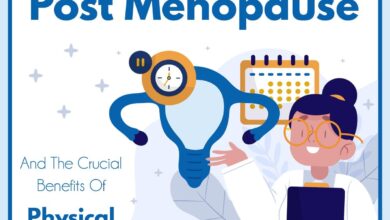
Signs of Low Oestrogen Levels in Your Body
Signs of low oestrogen levels in your body can be subtle, sometimes manifesting as seemingly unrelated symptoms. From irregular periods and vaginal dryness to changes in mood and bone density, the impact of fluctuating oestrogen can be significant. This post explores the various ways low oestrogen might be showing up in your life, empowering you to recognize the signs and take proactive steps towards your well-being.
Understanding your body is key, and recognizing these potential indicators can be the first step towards addressing any concerns.
We’ll delve into the physical manifestations, from changes in your menstrual cycle and reproductive health to skin and hair alterations. We’ll also explore the less obvious signs, such as mood swings, cognitive changes, and metabolic shifts. By the end, you’ll have a clearer understanding of what to look for and when to seek professional advice. Remember, this information is for educational purposes and isn’t a substitute for a doctor’s diagnosis.
Understanding Estrogen’s Role in the Body
Estrogen is a crucial hormone in the female body, playing a vital role in numerous physiological processes, from puberty to menopause. Its influence extends far beyond reproductive health, impacting various aspects of a woman’s well-being. A proper understanding of estrogen’s functions is key to recognizing potential imbalances and their associated symptoms.Estrogen’s primary functions include regulating the menstrual cycle, supporting the development and maintenance of the female reproductive system, including the uterus, fallopian tubes, and vagina.
It also contributes significantly to bone health, preventing osteoporosis by stimulating bone formation and inhibiting bone resorption. Furthermore, estrogen plays a role in cardiovascular health, maintaining healthy cholesterol levels and protecting against heart disease. Its influence extends to cognitive function, impacting memory and mood, and it also affects skin elasticity and hydration.
Hormonal Changes Throughout a Woman’s Life
A woman’s estrogen levels naturally fluctuate throughout her life, undergoing significant changes during puberty, pregnancy, breastfeeding, and menopause. During puberty, estrogen levels rise dramatically, triggering the development of secondary sexual characteristics, such as breast development and the onset of menstruation. Pregnancy is marked by a significant increase in estrogen production, essential for supporting fetal growth and development. After childbirth, estrogen levels gradually decrease during breastfeeding.
Menopause represents a significant hormonal shift, as estrogen production declines sharply, leading to the cessation of menstruation. These natural fluctuations highlight the dynamic nature of estrogen in a woman’s body and its impact on various life stages.
Factors Contributing to Low Estrogen Levels
Several factors can contribute to lower-than-normal estrogen levels. These include premature ovarian failure, a condition where the ovaries cease functioning before age 40, resulting in a significant drop in estrogen production. Surgical removal of the ovaries (oophorectomy) also leads to a complete cessation of estrogen production. Certain medical conditions, such as Turner syndrome and autoimmune disorders, can also affect estrogen levels.
Furthermore, lifestyle factors such as poor diet, excessive exercise, and chronic stress can indirectly influence estrogen production. Finally, genetic predisposition can play a role in determining a woman’s estrogen levels. Understanding these factors is crucial for identifying potential causes of low estrogen and developing appropriate management strategies.
Physical Signs of Low Estrogen: Signs Of Low Oestrogen Levels In Your Body

Source: pinimg.com
Estrogen plays a crucial role in regulating a woman’s reproductive system, and its deficiency can manifest in various ways, most notably through disruptions to the menstrual cycle. Understanding the typical characteristics of a healthy cycle is key to recognizing potential irregularities that might signal low estrogen levels. This understanding empowers women to seek appropriate medical advice when necessary.
Menstrual Cycle Irregularities as a Sign of Low Estrogen
A regular menstrual cycle typically spans 21 to 35 days, with bleeding lasting for three to seven days. The amount of bleeding can vary between individuals, but it’s generally considered normal for the flow to be moderate. Significant deviations from this pattern, particularly in the frequency, duration, or amount of bleeding, can indicate hormonal imbalances, including low estrogen.
Types of Menstrual Irregularities Associated with Low Estrogen
Different types of menstrual irregularities can be indicative of low estrogen. These irregularities represent a spectrum of changes, ranging from subtle shifts to significant disruptions in the cycle.
- Oligomenorrhea: This refers to infrequent periods, occurring less frequently than every 35 days. For example, a woman who experiences periods only every two or three months might be experiencing oligomenorrhea. This reduced frequency is often a direct consequence of insufficient estrogen production, leading to a less frequent release of the egg and subsequent menstruation.
- Amenorrhea: This is the absence of menstruation for three or more months in women who are not pregnant, breastfeeding, or undergoing menopause. Amenorrhea is a significant sign of low estrogen and warrants immediate medical attention. For instance, a woman who previously had regular cycles and suddenly stops menstruating should consult a doctor to investigate the underlying cause, which could be related to low estrogen or other health concerns.
- Menorrhagia: While often associated with high estrogen, prolonged or excessively heavy bleeding (menorrhagia) can also be a sign of low estrogen in some cases. This is because the hormonal imbalance can affect the uterine lining, causing irregular shedding and heavy bleeding. For example, a woman who experiences soaking through more than one pad or tampon per hour for several hours might be experiencing menorrhagia.
- Hypomenorrhea: This describes unusually light menstrual bleeding, often lasting for only a few days and with a significantly reduced flow. Like menorrhagia, this seemingly opposite irregularity can also be a symptom of hormonal imbalance and low estrogen, reflecting an insufficient buildup of the uterine lining.
Relationship Between Irregular Bleeding and Estrogen Deficiency
The relationship between irregular bleeding and estrogen deficiency is complex. Estrogen plays a critical role in the thickening of the uterine lining (endometrium) in preparation for a potential pregnancy. If estrogen levels are low, the endometrium may not thicken sufficiently, resulting in light or absent periods (hypomenorrhea or amenorrhea). Conversely, if the lining sheds unevenly due to hormonal fluctuations, it can lead to heavier or prolonged bleeding (menorrhagia).
The body’s attempt to compensate for the estrogen deficiency can also manifest in irregular bleeding patterns. It’s important to note that irregular bleeding can have other causes, so it is crucial to consult a healthcare professional for proper diagnosis and management.
Physical Signs of Low Estrogen: Signs Of Low Oestrogen Levels In Your Body
Low estrogen levels can significantly impact various aspects of a woman’s health, and the reproductive system is particularly vulnerable to these changes. Understanding these changes is crucial for early diagnosis and management of estrogen deficiency. This section will focus on the physical manifestations of low estrogen within the reproductive system.
Changes in the Vagina and Vulva
Decreased estrogen leads to noticeable alterations in the vagina and vulva. The vaginal lining, normally thick and moist, becomes thinner and drier. This thinning, known as vaginal atrophy, can cause the vaginal walls to become less elastic and more fragile, increasing the risk of injury during intercourse or even from everyday activities. The vulva, the external genitalia, may also appear thinner and paler due to reduced blood flow and collagen production.
These changes are not merely cosmetic; they contribute significantly to the discomfort often associated with low estrogen.
Vaginal Dryness and Discomfort
Vaginal dryness is a hallmark symptom of low estrogen. The reduction in vaginal lubrication makes intercourse painful (dyspareunia) and can lead to discomfort during routine activities like urination. The thin, dry vaginal lining is also more susceptible to infections, including bacterial vaginosis and yeast infections. This increased vulnerability stems from the loss of the protective, acidic environment normally maintained by estrogen.
The discomfort can range from mild irritation to significant pain, impacting a woman’s quality of life and potentially affecting her relationships.
Impact on Sexual Function and Libido
Low estrogen levels can significantly affect sexual function and libido. The vaginal dryness and discomfort already discussed directly impact sexual activity, making intercourse painful and unpleasant. Beyond physical discomfort, low estrogen can also affect sexual desire. While the exact mechanisms aren’t fully understood, the hormonal changes associated with estrogen deficiency can alter brain chemistry and neurotransmitters that regulate libido, leading to decreased sexual desire and arousal.
This can contribute to feelings of frustration and negatively impact a woman’s overall well-being and relationship satisfaction. For example, a woman experiencing perimenopause might notice a significant decrease in her libido alongside other symptoms like hot flashes and irregular periods. This is directly linked to the fluctuating estrogen levels during this transitional phase of life.
Physical Signs of Low Estrogen: Signs Of Low Oestrogen Levels In Your Body
Estrogen plays a crucial role in maintaining the health and appearance of our skin and hair. A decline in estrogen levels, often associated with menopause or other hormonal imbalances, can manifest in several noticeable ways, impacting both the texture and overall condition of these features. Understanding these changes can help women recognize potential hormonal shifts and seek appropriate medical advice if needed.
Skin Texture, Dryness, and Elasticity
Estrogen contributes significantly to skin hydration and elasticity. It stimulates collagen and elastin production, the proteins responsible for maintaining skin firmness and suppleness. When estrogen levels drop, collagen and elastin production decreases, leading to thinner, drier skin that loses its elasticity. This can result in increased wrinkles, sagging, and a generally rougher texture. The skin may feel less smooth and more prone to dryness, particularly in areas like the face, neck, and hands.
This dryness can sometimes be quite severe, leading to itching and discomfort. For example, a woman experiencing menopause might notice a significant increase in wrinkles and dryness compared to her pre-menopausal years.
Hair Loss or Thinning Hair
Low estrogen levels are often associated with hair thinning or hair loss. Estrogen helps regulate the hair growth cycle, and its deficiency can disrupt this cycle, leading to shorter hair growth phases and increased shedding. This can manifest as overall thinning, particularly noticeable in the scalp. In some cases, women may experience a receding hairline or widening part.
The hair itself may also become drier and more brittle. The severity of hair loss varies considerably from person to person, and other factors can also contribute to hair thinning, but a significant drop in estrogen is frequently a contributing factor. A woman experiencing post-partum hair loss might notice her hair thinning significantly more after the baby is born due to the hormonal shifts following pregnancy and childbirth.
Acne and Other Skin Conditions
While estrogen is often associated with acne during puberty, its deficiency in adulthood can also trigger or exacerbate acne. Estrogen helps regulate sebum production (oil production in the skin). Low estrogen can lead to an increase in sebum production, which can clog pores and contribute to acne breakouts. Other skin conditions, such as eczema and rosacea, may also be influenced by estrogen levels.
Fluctuations in estrogen can worsen the symptoms of these conditions, making the skin more prone to inflammation and irritation. For example, a woman approaching menopause might experience a resurgence of acne or a worsening of existing skin conditions as her estrogen levels decline.
Physical Signs of Low Estrogen: Signs Of Low Oestrogen Levels In Your Body

Source: drruscio.com
Estrogen plays a crucial role in maintaining various bodily functions, and its deficiency can manifest in several ways, impacting not only reproductive health but also bone health and metabolism. Understanding these interconnected effects is vital for recognizing and addressing potential estrogen deficiency.
Estrogen’s Influence on Bone Density and Strength
Estrogen is essential for maintaining bone density and strength. It works by stimulating osteoblasts, the cells responsible for building new bone tissue, while inhibiting osteoclasts, the cells that break down bone. This delicate balance ensures that bone mass remains stable and strong, protecting against fractures. During a woman’s reproductive years, estrogen levels are relatively high, promoting optimal bone health.
However, after menopause, the significant drop in estrogen levels disrupts this balance, leading to increased bone loss.
Low Estrogen and the Increased Risk of Osteoporosis and Fractures
The decline in estrogen after menopause significantly increases the risk of osteoporosis, a condition characterized by weakened bones and increased fracture risk. Without sufficient estrogen to support bone formation, the activity of osteoclasts becomes dominant, leading to a net loss of bone mineral density. This loss makes bones more fragile and susceptible to fractures, even from minor falls or impacts.
For example, a woman with osteoporosis might fracture her hip from a simple stumble, while a woman with healthy bone density would likely not experience such an injury. The resulting fractures can significantly impact quality of life, mobility, and independence.
The Link Between Low Estrogen and Metabolic Changes, Including Weight Gain
Low estrogen levels can also contribute to metabolic changes, sometimes resulting in weight gain. Estrogen influences fat distribution, typically leading to a more pear-shaped body type in women with normal estrogen levels. However, when estrogen levels are low, this distribution can shift, leading to increased abdominal fat accumulation, which is associated with increased risk of cardiovascular disease and type 2 diabetes.
Furthermore, estrogen plays a role in regulating insulin sensitivity. Reduced estrogen can lead to insulin resistance, making it more difficult for the body to process glucose effectively, potentially leading to weight gain and other metabolic complications. This effect is often observed in postmenopausal women.
Physical Signs of Low Estrogen: Signs Of Low Oestrogen Levels In Your Body
Estrogen plays a crucial role in a woman’s overall well-being, influencing not only physical health but also mental and emotional state. A decline in estrogen levels, often associated with perimenopause and menopause, can manifest in a variety of ways, impacting mood, cognition, and sleep. Understanding these changes is key to managing the transition and seeking appropriate support.
Mood Swings, Irritability, and Anxiety
Fluctuations in estrogen levels are strongly linked to shifts in mood. Lower estrogen can lead to increased irritability, emotional lability (meaning rapid mood changes), and heightened anxiety. This is because estrogen influences the production and regulation of neurotransmitters like serotonin and dopamine, which play a significant role in mood regulation. For example, a woman experiencing perimenopause might find herself becoming easily frustrated or tearful, experiencing heightened anxiety in situations that previously wouldn’t have bothered her, or swinging between periods of intense happiness and deep sadness within a short timeframe.
The severity of these symptoms varies greatly from person to person. Some women experience only mild mood disturbances, while others find their symptoms significantly impact their daily lives.
Cognitive Changes: Memory Problems and Difficulty Concentrating
Beyond mood, estrogen deficiency can also affect cognitive function. Lower estrogen levels have been associated with difficulties in memory recall, decreased concentration, and problems with executive function (the ability to plan, organize, and execute tasks). This isn’t necessarily indicative of dementia or other serious cognitive decline, but rather a reflection of the hormone’s influence on brain structure and function.
Spotting irregular periods or experiencing vaginal dryness? These could be signs of low oestrogen levels, impacting your overall well-being. It’s amazing to see advancements in other areas of medicine, like the fda approves clinical trials for pig kidney transplants in humans , which highlights the incredible progress in medical science. Understanding your hormonal balance, including oestrogen levels, is crucial for proactive health management, so don’t ignore those subtle changes your body might be signaling.
Imagine a woman struggling to remember appointments or names, finding it challenging to complete tasks requiring focus, or experiencing “brain fog” – a feeling of mental cloudiness and disorientation. These experiences are common among women experiencing estrogen decline and often improve with appropriate management.
Impact on Sleep Patterns and Quality of Sleep
Sleep disturbances are another common symptom associated with low estrogen. Estrogen plays a role in regulating the sleep-wake cycle, and its decline can lead to insomnia, difficulty falling asleep, frequent awakenings during the night, and poor sleep quality. The resulting sleep deprivation can exacerbate other symptoms of low estrogen, such as mood swings and cognitive difficulties. For instance, a woman might find herself tossing and turning for hours before finally drifting off to sleep, only to wake up feeling unrefreshed and exhausted, impacting her energy levels and mood throughout the day.
The hormonal changes associated with perimenopause and menopause can disrupt the natural sleep architecture, leading to a less restorative sleep experience.
Illustrative Table: Summarizing Physical Signs of Low Estrogen
Understanding the various physical manifestations of low estrogen can be challenging, as symptoms can be subtle and vary widely between individuals. This table provides a concise summary of common symptoms, their descriptions, potential severity, and possible related conditions, helping you to better understand and potentially address any concerns. Remember, this information is for educational purposes only and should not replace a consultation with a healthcare professional.
Physical Signs of Low Estrogen: A Summary Table
| Symptom | Description | Severity | Possible Related Conditions |
|---|---|---|---|
| Vaginal Dryness | Reduced vaginal lubrication, leading to discomfort during intercourse. | Mild to Severe | Menopause, perimenopause, certain medications |
| Hot Flashes | Sudden feelings of intense heat, often accompanied by sweating and redness. | Mild to Severe | Menopause, perimenopause, hormonal imbalances |
| Night Sweats | Excessive sweating during sleep, often leading to disrupted sleep. | Mild to Severe | Menopause, perimenopause, hormonal imbalances |
| Irregular Periods | Changes in menstrual cycle frequency, duration, or flow. | Mild to Severe | Perimenopause, menopause, polycystic ovary syndrome (PCOS) |
| Weight Gain | Increase in body weight, often concentrated around the abdomen. | Mild to Severe | Menopause, hormonal imbalances, thyroid issues |
| Thinning Hair | Loss of hair density, often noticeable on the scalp. | Mild to Severe | Menopause, hormonal imbalances, nutritional deficiencies |
| Decreased Libido | Reduced sexual desire. | Mild to Severe | Menopause, relationship issues, stress, depression |
| Mood Swings | Experiencing significant shifts in mood, from irritability to sadness. | Mild to Severe | Menopause, perimenopause, depression, anxiety |
Illustrative Descriptions
Visualizing the symptoms of low estrogen can be helpful in understanding their impact on your body. The following descriptions aim to provide a clear picture of what these changes might look like, allowing you to better recognize them and discuss them with your healthcare provider. Remember that the severity of these symptoms varies greatly from person to person.
So, you’re noticing some changes – maybe irregular periods or vaginal dryness? These could be signs of low oestrogen levels, and it’s worth chatting to your doctor. It’s fascinating to consider how other health markers might indicate underlying issues; for example, did you know that research is exploring whether an eye test can detect dementia risk in older adults, as discussed in this article: can eye test detect dementia risk in older adults ?
Understanding these connections helps us advocate for comprehensive health assessments, including those focusing on hormonal balance. Early detection is key for managing both hormonal changes and other age-related concerns.
Vaginal Dryness
Imagine the delicate skin of the vagina feeling parched, like sandpaper rather than its usual supple, moist state. This dryness can be uncomfortable, even painful, particularly during intercourse. The tissues may appear less plump and vibrant, perhaps even slightly reddened or irritated in some cases. The lack of lubrication can lead to a feeling of tightness and discomfort, making even simple activities like urination feel strained.
This dryness isn’t just a superficial change; it reflects a deeper hormonal imbalance.
Spotting the signs of low oestrogen, like irregular periods or decreased libido, can be tricky. It’s a reminder that hormonal imbalances affect everyone differently, and sometimes seemingly unrelated issues can be connected. For example, understanding the complexities of conditions like Tourette Syndrome in children, and finding effective management strategies as outlined in this helpful article, strategies to manage Tourette syndrome in children , highlights the importance of seeking professional help for any health concern, including hormonal fluctuations.
Paying attention to your body and seeking medical advice is key to addressing both subtle symptoms like low oestrogen and more complex conditions.
Thinning Hair
Picture your hair, once thick and lustrous, now appearing noticeably thinner and less full. The scalp might be more visible, and individual strands may seem finer and more brittle. Instead of a healthy, voluminous mane, you might notice increased shedding, perhaps finding more hair in your brush or on your pillow than usual. The hair itself might lack its former shine, appearing dull and lifeless.
This isn’t necessarily just about hair loss; the overall quality and texture of the hair changes significantly.
Changes in Skin Texture, Signs of low oestrogen levels in your body
Consider the texture of your skin. Instead of a smooth, even complexion, you might notice dryness, increased wrinkling, and a loss of elasticity. The skin might feel thinner and more fragile, perhaps more prone to bruising or irritation. The overall tone might appear duller, with a loss of that youthful radiance. Fine lines and wrinkles, particularly around the eyes and mouth, may become more pronounced.
The skin might feel less firm and more susceptible to dryness and irritation. This change in texture reflects the crucial role estrogen plays in maintaining skin health and hydration.
Final Conclusion

Source: inito.com
Recognizing the signs of low oestrogen is a powerful step towards better health and well-being. While this post has highlighted many potential indicators, remember that every woman’s experience is unique. If you’re concerned about your hormone levels, don’t hesitate to reach out to your doctor or a healthcare professional. They can provide a proper diagnosis and guide you towards appropriate treatment or lifestyle adjustments.
Prioritizing your health and seeking support when needed is crucial for maintaining a balanced and fulfilling life.
Popular Questions
Can stress affect my oestrogen levels?
Yes, chronic stress can significantly impact hormone production, including oestrogen levels. Managing stress through techniques like exercise, mindfulness, or therapy can be beneficial.
Is weight gain always a sign of low oestrogen?
Not necessarily. Weight gain can be linked to various factors, and while low oestrogen can contribute to metabolic changes that lead to weight gain, it’s not the sole cause. Other factors like diet and exercise play a significant role.
What tests can my doctor do to check my oestrogen levels?
Your doctor might order blood tests to measure your oestrogen levels. The specific tests will depend on your individual circumstances and symptoms.
Are there natural ways to boost oestrogen levels?
Some lifestyle changes, like regular exercise, a balanced diet rich in phytoestrogens (found in soy and flaxseed), and stress management techniques, might help support healthy oestrogen levels. However, it’s crucial to consult a doctor before making significant dietary or lifestyle changes.





